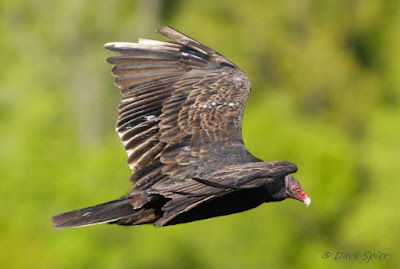(Introduction) -- © Dave Spier
Turkey Vultures (Cathartes aura) are fairly easy to recognize, assuming decent light and proximity. If you encounter them gliding along in search of dead animals to eat, look for several things. From the front (approaching you) or the rear (going away), the wings are held in a shallow V called a dihedral. When passing overhead, the wings are two-toned with the forewing ("solid" portions) dark while the flight feathers along the trailing (rear) edge and wingtips are lighter gray or even silvery. The head appears small because it lacks feathers. At closer range, the adult's head is red while juveniles are gray or dark headed.
For their size, vultures are relatively light weight. They are easily buffeted by wind so their flight often appears wobbly.
Their diet consists of carrion, primarily road-kills in populated areas, which they find with their keen sense of smell. The lack of feathers on the head is a sanitary adaptation related to probing into corpses. Feathers would hold scraps that become diseased.
Turkey Vultures are certainly common in Western New York. As of June 3, 2016, a total of 25,718 passed the Braddock Bay Hawkwatch during spring migration on their way east and north. Some will stay and nest in Central New York while others keep going. The vast majority will return south next fall, but a handful can be found in Letchworth State Park year-round. In the winter, they shelter out of the wind by roosting on cliff ledges below the rim. In the morning, the sun warms the rocks and the vultures begin to ride thermals (warm air currents) that help them gain altitude. For more spring photos taken at Letchworth, including several in this blog, see eBird checklist S10396306.
For more information, a range map, photos and sounds of Turkey Vultures, visit the All About Birds website. An interactive range map (zoomable to your location) can be found in the eBird Explore Data section here (or go to that page and type in any other species of interest).
Although it's possible to encounter a Black Vulture (Coragyps atratus) in Western New York, it's far less likely. (Only one passed Braddock Bay this spring.) Several quick ID distinctions are that only the wingtips are lighter-colored in Black Vultures and the head is never red. For more information and a range map, there's also an ID page for this species.
Corrections, comments and questions are always welcome at northeastnaturalist@yahoo.com or connect through my Facebook page and photo page. There's also a community-type page for The Northeast Naturalist.




3 comments:
Good to see a new entry. We have moved from Western NY to Eastern TN and see vultures regularly in our area I have not tried to identify variety. Our new place backs up to Cherokee National Forest.
Dave, glad to see your blog active again. Good update on Turkey Vulture activity.
Vishawat.blogspot.com
Post a Comment